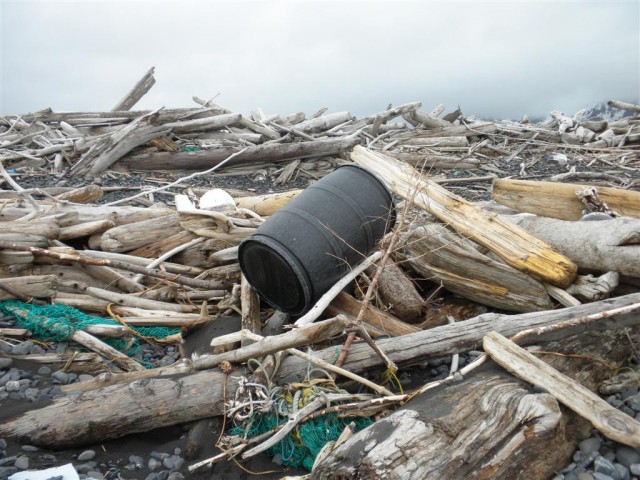First wave of Japan tsunami debris hits Alaska

The first wave of Japanese tsunami debris has hit Alaskan shores and is turning part of the area into a landfill. There is no abnormal level of radiation but much of it is toxic, according to CNN video posted below.
On Kayak Island, roughly 100 km (60 miles) southeast of Cordova, hundreds of buoys, thousands of bottles, countless fuel cans, shoes, chunks of building insulation, and other household items litter the beach for miles.
It’s even worse on Montague Island, according to Chris Pallister, president of Gulf of Alaska Keeper, a non-profit group which cleans up beaches each spring and summer.
“It’s a staggering mess,” he said during a visit to Kayak Island last Friday, “the magnitude of this is just hard to comprehend and I’ve been looking at this stuff a long time.”
“It is going to take years to clean this mess up,” he told CNN.

U.S. Sen. Mark Begich wants the federal government to provide at least $45 million to clean up debris that will land on U.S. shores from last year’s tsunami in Japan.
While the National Oceanic and Atmospheric Administration has been tracking the problem, Begich says it has limited resources and cannot alone be expected to handle what he calls a “monumental crisis.”
Begich says the debris that’s already washed ashore in Alaska is just the beginning of what he calls a “slow-motion environmental disaster that will unfold over the next several years.”
The Japanese government estimated that the tsunami generated 25 million tons of rubble, but there is no clear understanding of exactly how much debris was swept into the water nor what remained afloat.
The floating debris – which includes destroyed homes, wrecked fishing vessels, and even human remains – is shown in a computerized projection crafted by researchers at the University of Hawaii at Manoa, who say by 2014 the wreckage will stretch from Alaska to Mexico.
The projections, made by Nikolai Maximenko and Jan Hafner at the International Pacific Research Center, show a destructive path covering more than 7200 km (4,500 miles) on Pacific Ocean currents, pushed by wind and water to reach the far-reaching beaches of North America.


The larger debris field is now expected to come ashore this year, according to new estimates by the National Oceanic and Atmospheric Administration.
An earlier model had suggested that the bulk of the debris, which is now dispersed north of the Hawaiian islands, would wash up on the West Coast next year. But now government agencies and local volunteer groups are moving their preparations forward.
Sources: oceanservice.noaa.gov, csmonitor.com, dailymail.co.uk, thesunbreak.com, ktuu.com, adn.com, cnn.com, goak.org
Featured image: Marine debris found at Beach River. Image by Chris Pallister – Gulf of Alaska Keeper – www.goak.org

how much can be reused? Melted sown? There is money in trash. I know because
I reuse in as many ways as possible which saves/earns me money. what I don’t reuse
my garbage guy charges me an ever growing fee to haul off.